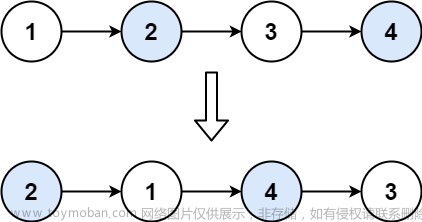day 4 链表
24. 两两交换链表中的节点
使用dummy节点可以极大地简化过程
/**
* Definition for singly-linked list.
* struct ListNode {
* int val;
* ListNode *next;
* ListNode() : val(0), next(nullptr) {}
* ListNode(int x) : val(x), next(nullptr) {}
* ListNode(int x, ListNode *next) : val(x), next(next) {}
* };
*/
class Solution {
public:
ListNode* swapPairs(ListNode* head) {
ListNode dummy(-1, head);
ListNode *cur = &dummy;
while (cur && cur->next && cur->next->next)
{
ListNode *first = cur->next;
ListNode *second = cur->next->next;
// 交换两个节点的位置
first->next = second->next;
second->next = first;
cur->next = second;
// 向后移动两个节点
cur = cur->next->next;
}
return dummy.next;
}
};
19. 删除链表的倒数第 N 个结点
有个地方折磨了我有一会儿,是粗心导致的,而且提示的错误也很难发现是哪里导致的。就是在case为head = [1], n = 1时,最后释放了tmp之后(此时tmp刚好指向head,我还return head;,意思就是操作了已经被我释放的内存,leetcode就报错了
/**
* Definition for singly-linked list.
* struct ListNode {
* int val;
* ListNode *next;
* ListNode() : val(0), next(nullptr) {}
* ListNode(int x) : val(x), next(nullptr) {}
* ListNode(int x, ListNode *next) : val(x), next(next) {}
* };
*/
class Solution {
public:
ListNode* removeNthFromEnd(ListNode* head, int n) {
ListNode dummy(-1, head);
ListNode *fast = &dummy;
while (fast->next && n--)
{
fast = fast->next;
}
ListNode *slow = &dummy;
while (fast->next)
{
fast = fast->next;
slow = slow->next;
}
ListNode *tmp = slow->next;
slow->next = slow->next->next;
delete tmp;
return dummy.next;
}
};
面试题 02.07. 链表相交
老生常谈的题目了
/**
* Definition for singly-linked list.
* struct ListNode {
* int val;
* ListNode *next;
* ListNode(int x) : val(x), next(NULL) {}
* };
*/
class Solution {
public:
ListNode *getIntersectionNode(ListNode *headA, ListNode *headB) {
ListNode *curA = headA, *curB = headB;
while (curA != curB)
{
curA = curA ? curA->next : headB;
curB = curB ? curB->next : headA;
}
return curA;
}
};
142. 环形链表II
还是用快慢指针,如果能够相遇,证明存在环
/**
* Definition for singly-linked list.
* struct ListNode {
* int val;
* ListNode *next;
* ListNode(int x) : val(x), next(NULL) {}
* };
*/
class Solution {
public:
bool detectCycle(ListNode *head) {
ListNode *slow = head, *fast = head;
while (fast && fast->next) // 如果不存在环,fast会先链表末尾nullptr,会跳出循环
{
slow = slow->next;
fast = fast->next->next;
if (slow == fast) return true; // 应该要返回相交的那个节点才对
}
return false;
}
};
返回相交的那个节点
/**
* Definition for singly-linked list.
* struct ListNode {
* int val;
* ListNode *next;
* ListNode(int x) : val(x), next(NULL) {}
* };
*/
class Solution {
public:
ListNode *detectCycle(ListNode *head) {
ListNode *slow = head, *fast = head;
bool flag = false;
while (fast && fast->next)
{
slow = slow->next;
fast = fast->next->next;
if (slow == fast)
{
flag = true;
break;
}
}
if (flag) // 存在环
{
ListNode *cur = head;
while (cur != fast)
{
cur = cur->next;
fast = fast->next;
}
return cur;
}
else // 不存在环
{
return nullptr;
}
}
};
个人理解
如果存在环的话,slow指针走一步,fast指针走两步,两个指针总能相遇。因为fast指针走的快,在存在环的情况下,fast总能”追“上slow。因此,可以用这个方法判断有没有环存在。
在确定有环存在之后,顺便能得到slow指针和fast指针相遇的位置。因为fast的步数是slow的两倍,记从head到slow的步数为a,那么fast走过的步数为2a,在这个链表中,走过a步和走过2a步最终能到达同一个节点。为了求环的入口点,我们可以设置两个指针,一个从起始位置head开始,一个从a位置开始,一同出发,最终一定能在2a位置相遇,由于2a处于环内,那么在2a之前它们实际上已经重合,再往前推,它们在环的入口点就已经重合。所以它们第一次相遇的点,就是环的入口点!文章来源:https://www.toymoban.com/news/detail-483473.html
以上都是我自己理解的方法,数学证明的话可以看随想录的笔记。文章来源地址https://www.toymoban.com/news/detail-483473.html
到了这里,关于算法刷题Day4 两两交换链表中的节点+删除链表的倒数第N个结点+链表相交+环形链表的文章就介绍完了。如果您还想了解更多内容,请在右上角搜索TOY模板网以前的文章或继续浏览下面的相关文章,希望大家以后多多支持TOY模板网!













